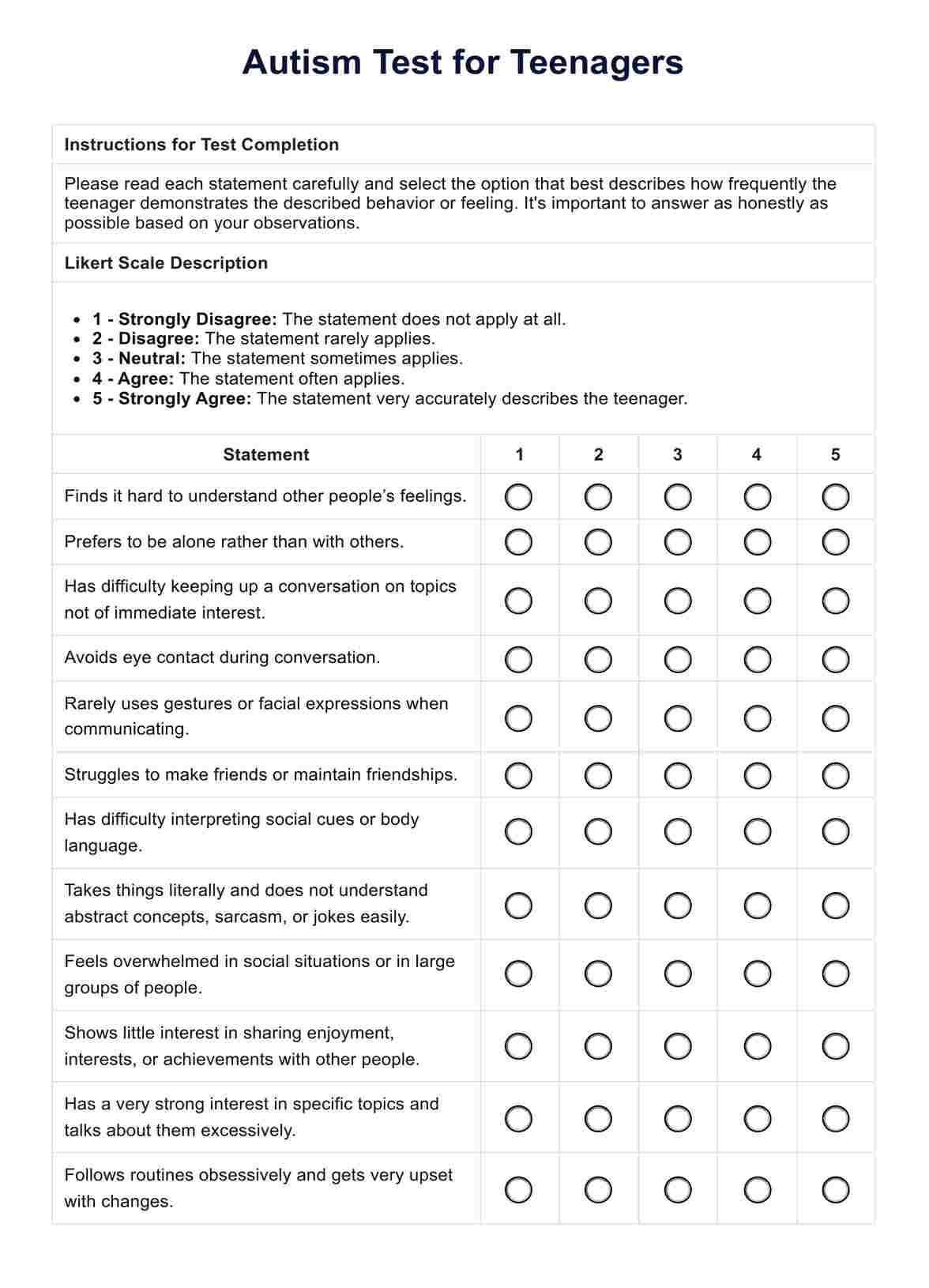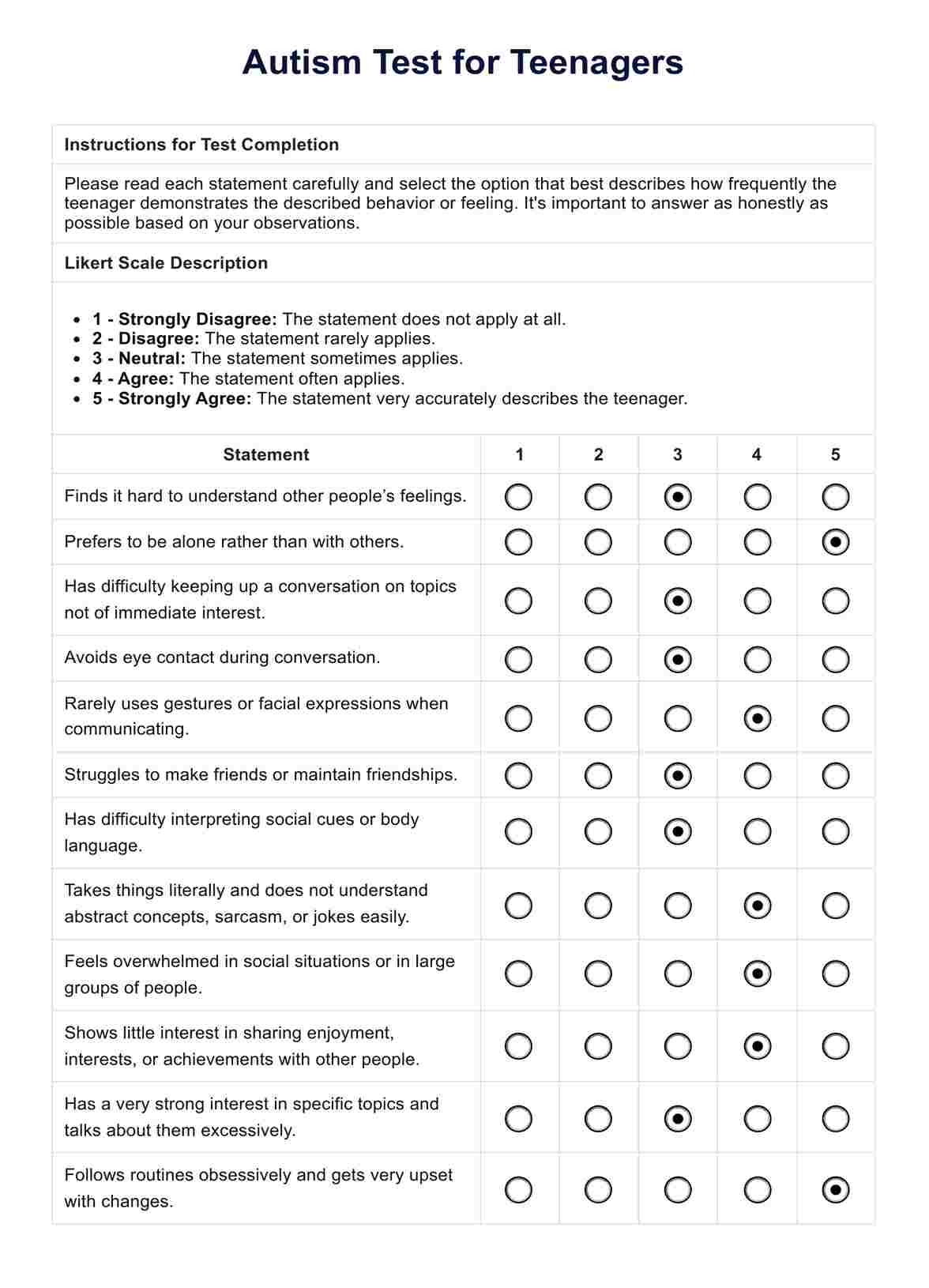Autism Test for Teenagers
Explore our Autism Test for Teenagers, designed to screen social interaction skills. Includes example questions. Get your Free PDF Download now.


What is autism?
Autism Spectrum Disorder (ASD) is a complex developmental condition that involves persistent challenges in social interaction, speech and nonverbal communication, and restricted/repetitive behaviors. The effects of ASD and the severity of symptoms are different in each person, ranging from requiring significant support in daily life to needing less assistance. A formal diagnosis of autism spectrum disorder is made through a comprehensive diagnostic assessment by a mental health professional, considering the individual's social communication signs and behaviors.
Autism tests and screening tools, such as the Autism Spectrum Screening Questionnaire, play a crucial role in the early detection and understanding of ASD. These tools are designed to identify individuals who may benefit from a more detailed autism assessment. For autistic teenagers, early autism screening and diagnosis can be vital in accessing the necessary support and interventions.
A formal diagnosis is based on observed social situations and communication challenges, among other criteria, evaluated by mental health professionals through various autism assessment methods.
Autism Test for Teenagers Template
Autism Test for Teenagers Example
Signs of autism in teenagers
ASD manifests through various signs and behaviors, which can become more apparent or evolve as children grow into their teenage years. While some individuals are diagnosed as toddlers, others may not be diagnosed until later when developmental differences become more pronounced. Recognizing the signs of autism in teenagers is crucial for understanding their needs and providing appropriate support.
Developmental differences in social situations
Older kids with autism may show noticeable differences in understanding and navigating social situations. They might struggle with interpreting social cues and conversation, such as body language or tone of voice, making it challenging to form and maintain friendships.
Challenges with verbal and nonverbal communication
Communication can be a significant hurdle. This includes difficulties in starting or carrying on conversations, limited eye contact, and an inability to use or interpret gestures effectively, which are crucial in social interactions.
Repetitive behaviors
Teens with autism might display repetitive behaviors or have very specific routines that they are reluctant to change. These behaviors can serve as a coping mechanism for managing daily uncertainties.
Intense interests or preoccupations
It's common for autistic teens to have intense interest in specific topics. These interests can dominate their conversations and leisure activities, often to the exclusion of other topics.
Sensory sensitivities
Many teens with autism are highly sensitive to sensory input. This can include adverse reactions to loud noises, specific textures, or lights, which can cause them to become anxious or upset in overwhelming environments.
Emotional regulation challenges
Managing emotions can be particularly challenging. Autistic teens might become easily upset or anxious, especially when confronted with unexpected changes to their routine or in stressful situations.
Understanding these signs is a step toward recognizing the unique challenges and strengths of autistic teenagers. Each individual's experience with autism is unique. While these signs can indicate the need for further evaluation, they also highlight areas where targeted support can significantly improve their quality of life.
How to diagnose autism in teenagers
Diagnosing autism in teenagers can be a nuanced process, as individuals with high-functioning autism may have learned to mask symptoms of autism to some extent, making it more challenging to recognize their struggles. It's not just about observing obvious challenges in interaction or communication; sometimes, it's the minor changes in behavior or the ability to notice small sounds that others might ignore that can be telling.
Teenagers on the autism spectrum might also experience trouble with changes in routine or environment that seem minor to others but are significant to them. These subtle signs are crucial for professionals to consider during the diagnostic assessment, along with more direct symptoms of autism observed in social settings, such as school, where pressures and social demands are heightened.
Online autism assessment and autism quizzes can serve as preliminary screening tools for parents and guardians to identify potential signs of autism in their teenagers. However, these tools cannot replace a comprehensive evaluation by a qualified professional.
The diagnostic process for autism involves thoroughly reviewing the teenager's development, including their current abilities and challenges. This typically includes interviews, observational assessments, and sometimes standardized tests conducted by mental health professionals specializing in autism.
This multi-faceted approach helps ensure that all aspects of the teenager's development and behavior are considered, providing a foundation for understanding their needs and determining the most effective support strategies.
How to use this template?
The Autism Test for Teenagers template is designed as a preliminary tool to help identify signs of autism, ASD, and Asperger Syndrome in young individuals. It is essential to approach this template with focus and understanding, recognizing that autism presents differently in every child. This guide is particularly useful for parents, guardians, and school professionals observing teenagers in various social situations and academic environments.
Step 1: Familiarization
Familiarize yourself with the template and the specific areas it assesses, such as social interaction, communication skills, and behavioral patterns. Understanding the scope of the template will help you accurately interpret the teenager's behaviors and preferences, especially in distinguishing between ASD and typical adolescent behaviors.
Step 2: Observation
Spend time observing the teenager in different settings, such as at school, solitary activities, and social situations. Note their ability to engage with peers and adults, understand people's intentions, and respond to social cues. This step is crucial as it provides real-life context that can highlight differences in social interaction and communication that might not be as apparent in more controlled settings.
Step 3: Completion
If appropriate, complete the template with the teenager by answering each question based on recent observations. Focus on the teenager's typical behavior rather than one-off incidents. Pay particular attention to questions relating to their ability to navigate social situations, engage in reciprocal communication, and interest in solitary activities versus group interactions.
Step 4: Reflect on very strong interests
Reflect specifically on any very strong interests or fixations the teenager has. Many individuals with ASD, including those with Asperger Syndrome, may display intense preoccupations with specific topics. Consider how these interests affect their social interactions and daily functioning. This reflection can provide insight into whether these are typical teenage passions or potentially indicative of ASD.
Step 5: Seek professional guidance
After using the template, review the results and consider seeking advice from a healthcare professional experienced in ASD. This step is critical, especially if the template indicates potential challenges that align with autism spectrum disorder traits. A professional can conduct a thorough assessment to understand the observed behaviors in the child's overall development and offer guidance on the next steps, including further evaluation, a formal diagnosis, or recommendations for support.
This template is a starting point for understanding a teenager's social and behavioral patterns. It's essential to remember that autism spectrum disorder is complex. A comprehensive evaluation by a qualified professional is necessary for a formal diagnosis and to tailor support and interventions to the individual's needs.
Results and interpretation
The results from an online autism test can offer preliminary insights into a child's social and communicative behaviors, which might suggest difficulties commonly associated with ASD. When interpreting these results, it's important to consider how the child navigates various social situations, especially compared to their peers.
Adolescents and older children, who are more aware of social dynamics, may experience trouble negotiating complex social interactions, which can become apparent through their responses on the test. These challenges could manifest in various ways, from misunderstanding social cues to difficulty maintaining friendships.
However, it's crucial to remember that an online autism test is the first step in understanding a child's social and communication needs. A detailed evaluation by a professional is necessary to fully assess the extent of any social difficulties and differentiate them from typical adolescent behaviors. This evaluation might reveal that while some adolescents struggle in social situations, their challenges might not necessarily align with ASD criteria.
For those identified with autism, the autism assessment results can guide professionals in recommending appropriate interventions and supports. For all children, but especially adolescents, navigating the complexities of social interactions and understanding and addressing these challenges early can significantly impact their development and quality of life.
Next steps
Following initial autism tests, the next step involves pursuing an in-depth evaluation with a professional to obtain an accurate diagnosis. This autism assessment is crucial, especially if the child prefers solitary activities over social interactions or exhibits behaviors that align with ASD criteria. Whether dealing with toddlers or older children, an in-depth evaluation by specialists is essential to fully understand the child's unique needs and challenges.
Such assessments go beyond preliminary screenings, providing a comprehensive overview that considers all child development aspects. An accurate diagnosis paves the way for tailored interventions and support, ensuring each child receives the guidance they need to thrive.
Commonly asked questions
A multidisciplinary team usually conducts the assessment, including a psychologist, a psychiatrist, a speech and language therapist, and sometimes an occupational therapist specializing in developmental disorders.
Autism can affect a teenager's social interactions, communication skills, and behavior, potentially leading to challenges with forming friendships, understanding social cues, and managing sensory sensitivities.
Early diagnosis of autism can lead to early intervention, which can significantly improve a child's development and quality of life. It allows for tailored support and education strategies to be implemented sooner, helping the child to develop essential social, communication, and behavioral skills.
Telling a teenager they are on the autism spectrum should be done sensitively and supportively, emphasizing their strengths and the support available to them. It's crucial to provide clear information about what autism is and how it affects them personally, ensuring they understand that it does not define their entire identity or limit their potential.





















-template.jpg)






















































































